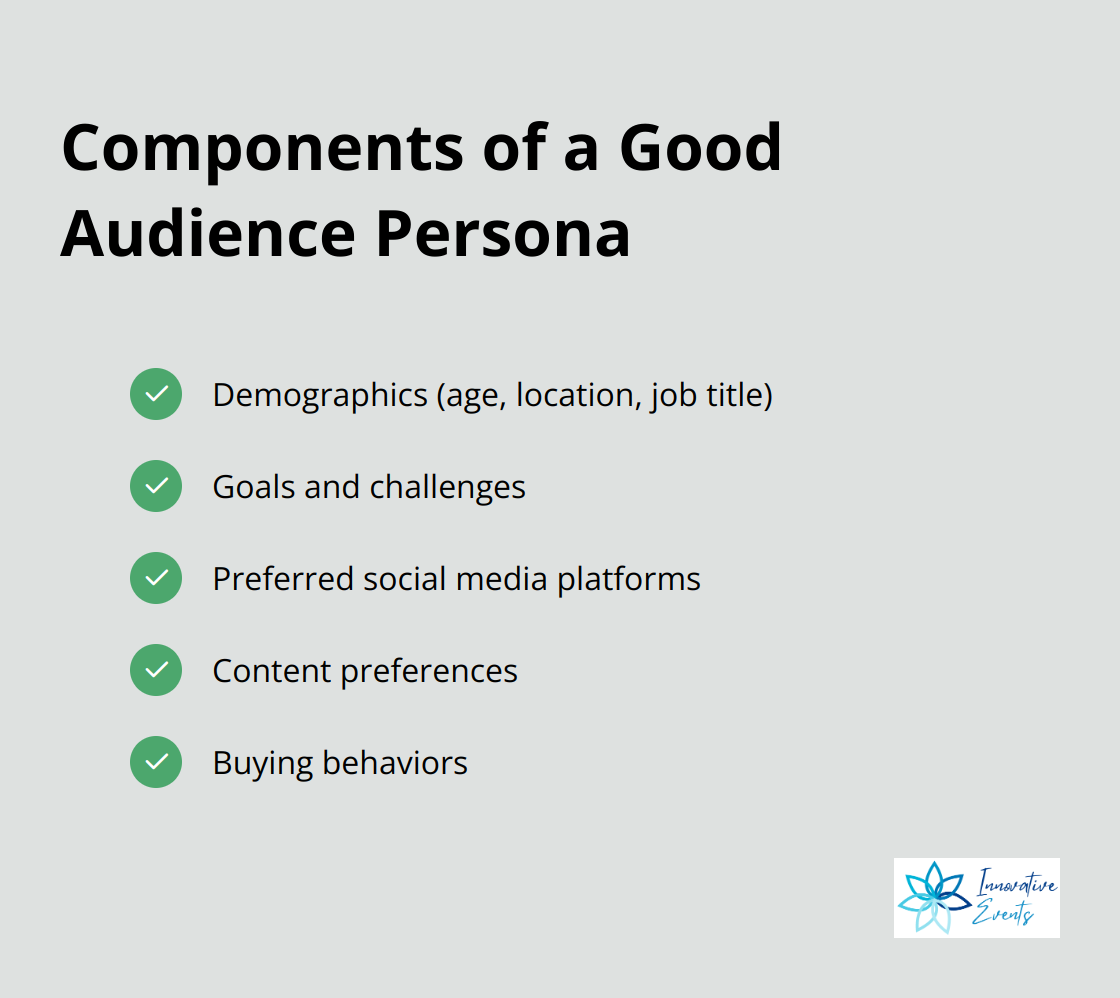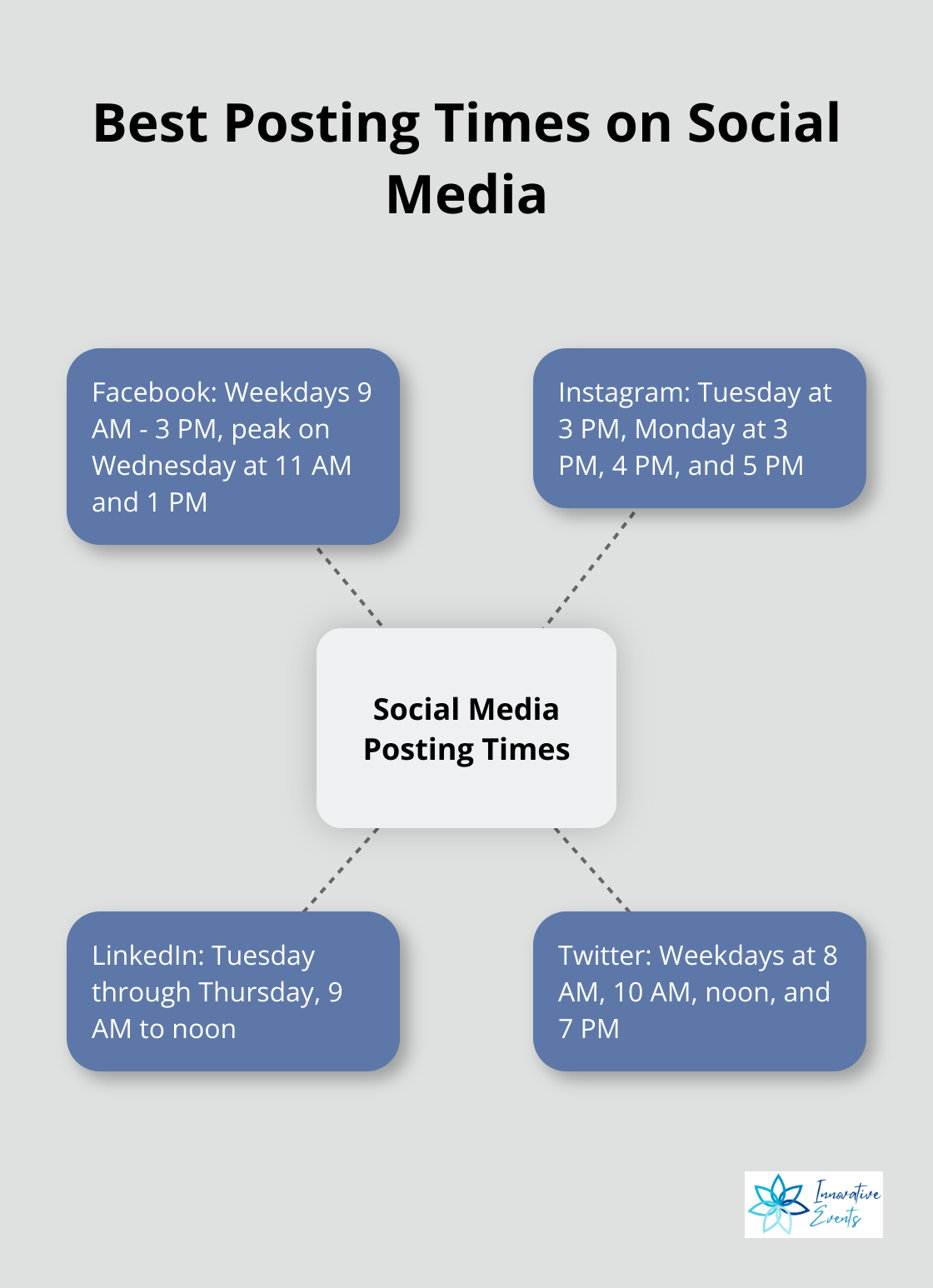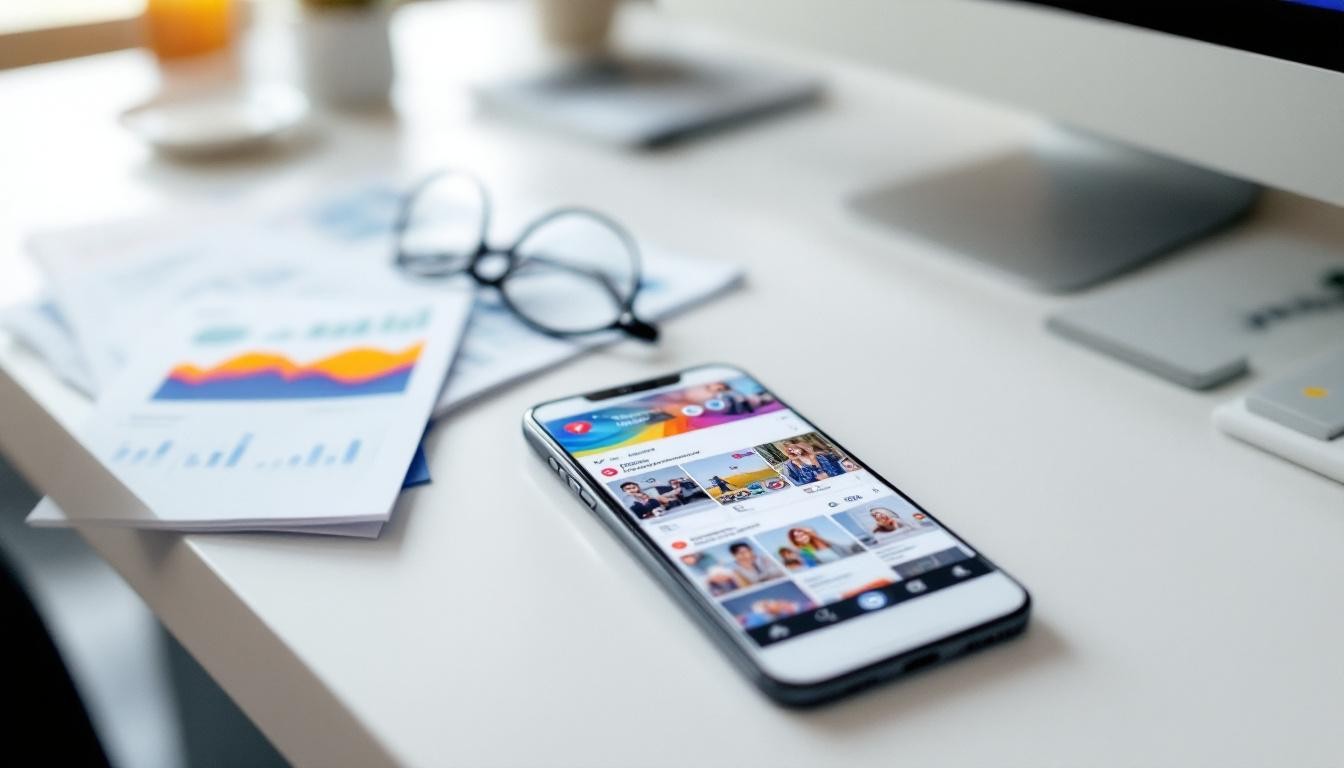At Innovative Events, we know that social media engagement can make or break your online presence.
Boosting your social media engagement isn’t just about posting more content. It’s about understanding your audience, creating content that resonates, and optimizing your posting strategy.
In this post, we’ll show you how to get more engagement on social media with practical tips and tools you can start using today.
Who Is Your Social Media Audience?
Uncover Audience Demographics
The first step to effective social media engagement is to know your audience. Social media audience analysis can help you discover insights that lead to increased engagement and brand loyalty. Most social media platforms provide built-in analytics tools. Facebook Insights offers detailed information about your page followers’ age, gender, location, and online behaviors. Instagram Insights provides similar data, plus information on when your followers are most active (a key factor for timing your posts).
For a more comprehensive view, tools like Sprout Social or Hootsuite aggregate data from multiple social networks. These platforms give you a holistic view of your audience across channels, allowing you to tailor your content strategy accordingly.
Analyze Behavior: Look Beyond Numbers
Demographics are just the beginning. To truly understand your audience, you must analyze their behavior. What type of content do they engage with most? Do they prefer videos, images, or text posts?
Examine your top-performing posts. What do they have in common? This analysis will guide your content creation strategy.
Social listening tools (such as Brandwatch or Mention) prove invaluable for understanding audience sentiment and trending topics. These tools monitor conversations about your brand and industry across social media, providing insights into what your audience truly cares about.
Create Actionable Audience Personas
With this data in hand, it’s time to create audience personas. These are fictional representations of your ideal followers, based on real data and market research.
A good persona includes:
- Demographics (age, location, job title)
- Goals and challenges
- Preferred social media platforms
- Content preferences
- Buying behaviors

Creating actionable personas involves defining your target audience, researching their content needs, identifying what’s working for competitors, and running a website content audit.
Keep Your Audience Research Fresh
Social media landscapes and user behaviors change rapidly. We recommend revisiting your audience analysis quarterly to ensure your strategy stays relevant and effective. This ongoing research will help you adapt to shifts in your audience’s preferences and behaviors, keeping your engagement rates high.
With a clear understanding of your audience, you’re ready to move on to the next critical step: creating engaging content that resonates with these personas and drives meaningful interactions.
What Content Drives Social Media Engagement?
Visual Content Reigns Supreme
Visual content is more engaging, easier to understand, and more memorable than text. It helps grab attention quickly in crowded feeds, making your brand more noticeable.
To maximize engagement, create high-quality, eye-catching visuals. Use bright colors, interesting compositions, and clear, crisp images. Infographics prove particularly effective (40% of marketers report original graphics like infographics and illustrations perform best).

Video content also excels in engagement. On Facebook, videos generate 59% more engagement than other post types. Live videos take it a step further, producing six times as many interactions as regular videos.
Craft Compelling Captions and Headlines
While visuals capture attention, captions and headlines maintain it. The opening words must hook the reader and encourage engagement.
Ask questions to spark comments. Use emojis strategically – posts with emojis receive 57% more likes and 33% more comments on Instagram. However, moderation is key; one or two emojis per post usually suffice.
Concise captions perform best. On Facebook, posts with 80 characters or fewer attract 66% more engagement. On Twitter, tweets between 71-100 characters receive 17% more engagement than longer ones.
Harness the Power of User-Generated Content
User-generated content (UGC) boosts engagement significantly. Brands implementing UGC in their marketing strategies see a lift in conversion rates and a 154% increase in revenue per visitor. When consumers interact with UGC, it offers authenticity, relatability, and builds trust.
Motivate your followers to create and share brand-related content. Organize contests, introduce branded hashtags, and showcase user content on your profile. This approach not only increases engagement but also fosters a sense of community around your brand.
Mix Up Your Content Types
Variety keeps your feed fresh and interesting. Try different content types:
- Behind-the-scenes content (humanizes your brand)
- Polls and quizzes (encourage active participation)
- Educational content (provides value to your audience)
- Trending topics and memes (show your brand’s personality)
Monitor the performance of different content types and adjust your strategy accordingly. What works for one brand might not work for another, so understanding what resonates with your specific audience is essential.
Engagement extends beyond likes and shares; it’s about creating meaningful interactions that build lasting relationships with your audience. The next chapter will explore how to optimize your posting strategy to ensure your carefully crafted content reaches your audience at the right time and frequency.
When Should You Post on Social Media?
Platform-Specific Timing
Different social media platforms have unique peak engagement times. Facebook sees high engagement on weekdays between 9 AM and 3 PM, with Wednesday at 11 AM and 1 PM as top performers. The best time to post on Instagram on Tuesday is at 3 p.m., with similar patterns on Monday and slightly lower peaks at 4 p.m. and 5 p.m. LinkedIn, catering to professionals, experiences peak activity Tuesday through Thursday, 9 AM to noon. Twitter’s fast-paced environment results in multiple daily peaks: weekdays at 8 AM, 10 AM, noon, and 7 PM.

Tailoring to Your Audience
These general guidelines serve as a starting point, but your specific audience might behave differently. Use social media analytics to determine when your followers are most active. Facebook Insights and Instagram Insights offer detailed breakdowns of follower activity by day and hour. Test various posting times and track engagement rates to find your optimal schedule.
Consistency trumps perfect timing. Regular posts at a less-than-optimal time yield better results than sporadic posts at “best” times.
Posting Frequency
The ideal posting frequency varies by platform. Twitter thrives on 3-5 tweets daily, while Facebook and LinkedIn perform well with 1-2 posts per day. Instagram can accommodate 1-3 posts daily, plus 5-10 stories.
Quality always outweighs quantity. One high-quality, engaging piece of content proves more effective than several mediocre posts. Monitor your engagement rates as you adjust your posting frequency to strike the right balance for your audience.
Leveraging Social Media Management Tools
Managing multiple platforms with different optimal posting times presents challenges. Social media management tools (such as Hootsuite, Buffer, and Sprout Social) allow you to schedule posts in advance, ensuring you hit peak engagement times even when offline.
These tools provide valuable analytics to refine your strategy. They track engagement rates, follower growth, and even sentiment analysis to offer a comprehensive view of your social media performance.
The Power of Experimentation
Social media landscapes evolve constantly. What works today might not work tomorrow. Embrace experimentation in your posting strategy. Try new times, frequencies, and content types. Keep a close eye on your analytics and adjust your approach based on real data.
(Pro tip: Use A/B testing to compare different posting times or frequencies directly.)
Final Thoughts
Boosting social media engagement requires a deep understanding of your audience, creative content creation, and strategic posting. You must use the tools and methods we’ve outlined to gain insights into your followers’ demographics, behaviors, and preferences. This knowledge will guide your content creation and posting strategy.
Visual content, compelling captions, and user-generated content are powerful tools to capture attention and encourage interaction. You should mix up your content types to keep your feed fresh and interesting. Optimizing your posting strategy ensures your carefully crafted content reaches your audience at the right time.
The key to long-term success is continuous improvement and adaptation. You need to regularly analyze your performance metrics and adjust your approach based on what works best for your audience. At Innovative Events, we help executives enhance their health and performance through our personalized, integrative lifestyle program. Start implementing these strategies today to get more engagement on social media.

